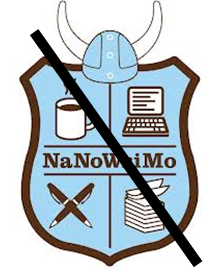Over on the Facebook Group for the 100k in 100Days Challenge, we don’t only talk about writing 100K words in 100 days. I know: it’s a shocker. We do mainly talk about writing, so if that doesn’t appeal, don’t join. Because it will bore you to tears, and life’s too short, even on a Grey day.
One of our recent natters intellectual debates was about languishing WIPS (works in progress, lovies. You’re new here, aren’t you? Welcome :D).
Why do we have them? How many do we have? Will we/should we, ever finish some/most/all of them? After I suggested that performing a personal WIP audit could be useful, suddenly the thread morphed into a secular online Confessional. Dozens of WIPs were admitted. The sin of Never Finishing any work above ‘short story length’ (a Grey area) was confessed (if this was a Vlog, you’d see me raising my hand here. As it isn’t, use your imagination). Some WIPs supposedly started when their authors were living in trees writing with a scratchy stick, but that was probably an exaggeration. Flamin’ writers.
Many of us felt we had at least a few WIPs worth retrieving from the Grey recesses of our archives – worth reviving or even completely rewriting, because the original idea was sound. How to do this logically, though, and how to balance the demands of ancient WIPs with the urge to start new stuff – that’s tricky. Or is it?As I’m all for giving an approving nod to other writers and their ideas, and this confessional mode is hard to get out of, I’ll tell you now that if you need help with this, How To Finish What You Start – A Five Step Plan For Writers – may be all you need to tackle this Grey area.
BUT if the Five Step Plan seems too harsh, and not to have that holding-your-hand-and-guiding-you-gently-through-the-thicket-of-thorns-to-the-rainbow-rose-garden approach that you prefer, you might need my Fifty Steps Of Completion plan (except there are only fifteen) to Whip those Whips into Submission, instead. And no, I didn’t call it that to get hits from people seeking certain volumes of erotic fiction, it just came to me (no double entendre intended). If that’s what I was after, I would have mentioned E.L.James and slipped in the word Grey everywhere. (Oh… whoops.) Without Further Ado, I give you…
Fifteen Shades of Completion: Whipping Your WIPs into Submission.
Get a notepad ready – you’ll need it in a minute. (Yes, and a pen as well. Smarty Pants).
- Dig out every notebook and scrap of paper with writing on that you possess (yes, that includes shopping lists. What do they tell you about the person who wrote it, or what they’re about to do? They make great prompts!). Put them in one place: a boxfile if they fit, a bedroom if they don’t (displace the occupant. It’s for the Greater Good). Label your boxfile/bedroom WIPs.
- Search tirelessly through documents, blog posts, Sticky Notes, files from MyNovel/Scrivener/NewNovelist etc for writing. Save in one folder: WIPs.
- Time to separate your WIPs from your PIPs. PIPs are Ponderings in Progress. Snatches of dialogue, interesting info, undeveloped ideas; any pieces less than about 5% of the intended finished length, count as PIPs.
- Gather PIPs together in one computer folder and/or notebook, scrapbook, expanding/lever-arch/box file. If there’s a related cutting, join your PIP to it: staple, paper clip, or stick them on the same scrapbook page. Then, when you need a new idea (maybe you ran out of WIPS; woo-hoo!) – all those brilliant seeds will be just waiting for you to come along and water them.
- FILE your PIPs, Make Way For Your WIPs! Label then store your PIPs.
- Only true WIPs left – got your notepad? LIST and number each one. No categorising, no comments, no ordering; just list. If it doesn’t have a title, assign one that clearly identifies it, e.g. 1. Watch The Wall 2. Ghost sport story.
- Go down the list. Star WIPs that excite you/give you a warm fuzzy feeling.
- Again! This time star WIPs when you think, ‘I know what I’m doing with that.’
- Again! This time star WIPs when you think, ‘I could finish that fairly quickly.’
- Again! This time, star WIPs when you think, ‘I already have a competition/ submission/other purpose in mind for that one, that has a deadline attached.’ If the deadline is in the near future, give it two stars.
- You may feel that there’s one kind of project that you never complete, whether (like me!) it’s longer projects, non-fiction, flash…so brandish that pen again and star projects that fall into your ‘always left to last’ category.
- If your list contains items without any stars, take a good long look at them. Are there any that you feel you will never want to work on again? Now’s the time to heartlessly slash through those items.
- Hopefully by now you will have a short list of starred items – with any luck some will have more than one star. Your stars should enable you to write out a prioritised WIP list.
- What you need now is a PLAN. A rule that works for you, to ensure your WIP list is tackled whilst writing new stuff. Now you could go cold turkey – as recommended by the 5 step Plan – and ban yourself from writing anything new at all. By all means do this is you can, although remember to at least briefly write down any ideas in your PIPs book! But this won’t work for many people, who need to write new material because they have commitments to do so and/or need to write to earn money; or who find just revitalising old material feels stifling, making them lose heart.
- So if you can’t go cold turkey, what are your options? Here are some rules I suggested to Gerald Hornsby on the 100K group (he took up my audit suggestion and ended up logging a bewildering amount of languishing WIPs!).
- ‘for every two new ideas I write up, I must finish 1 WIP’
- ‘for every 2000 words I write on something brand new, I must write X amount on a WIP’,
- ‘I will complete a WIP every two months’.
For any of these to work, it’s best to make a spreadsheet or some kind of record, to keep yourself honest, AND on track. Hope that’s cleared up any GREY areas 😉
Go on – DIG OUT THOSE WIPS AND MAKE IT HAPPEN! Good luck 😀





 See? That’s how I looked. Determined. But without the ginger hair. Or the earrings. And admittedly I rarely wear that shade of pink, but then with that hair colour, nor should she.
See? That’s how I looked. Determined. But without the ginger hair. Or the earrings. And admittedly I rarely wear that shade of pink, but then with that hair colour, nor should she.



